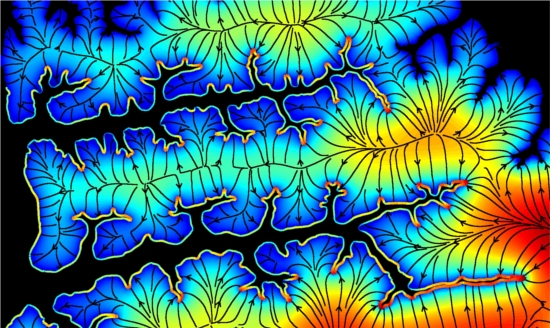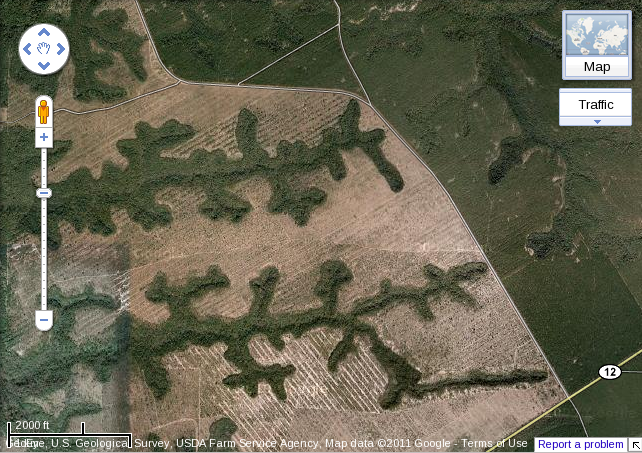PAOC Spotlights
On the Evolution of "Lovely Crinkly Bits"

When rain falls on sand, very little of it remains on the surface. Rather, most of the water is stored in pore-space as groundwater and only returns to the surface when it flows out of a spring. As groundwater drains out, it erodes the stream bed causing existing springs to move forward and providing new locations for springs to form. This combination of growth and nucleation produces a network of springs that compete with one another for groundwater. A focus of our work in Dan Rothman's Group is to understand the forms that emerge when a landscape grows according to this process.
 Our field site on the Florida Panhandle provides a stunning example of these so-called seepage channels. In the Apalachicola Bluffs and Ravines Preserve, nearly two hundred springs compete with one-another for groundwater in a network that extends kilometers. Because this network is growing in sand that is conveniently uniform, this field site provides the simplest possible example of a seepage network. To aid in the comparison of theory to observation, we have frequent field trips to measure, for example, the sediment and groundwater flux in the streams and the shape of the water table from a ground-penetrating radar survey. We also make frequent use of a high-resolution LIDAR map of the valley network.
Our field site on the Florida Panhandle provides a stunning example of these so-called seepage channels. In the Apalachicola Bluffs and Ravines Preserve, nearly two hundred springs compete with one-another for groundwater in a network that extends kilometers. Because this network is growing in sand that is conveniently uniform, this field site provides the simplest possible example of a seepage network. To aid in the comparison of theory to observation, we have frequent field trips to measure, for example, the sediment and groundwater flux in the streams and the shape of the water table from a ground-penetrating radar survey. We also make frequent use of a high-resolution LIDAR map of the valley network.
 The growth of a seepage network represents the coupling of two fundamental processes: the focusing of water into a stream and the flux of sand from the stream. It has been known for decades that groundwater is partitioned between springs according to a non-linear diffusion equation. Moreover, sediment is removed from the spring when the shear stress imposed by the flow of water exceeds a certain threshold while it is added to the stream due to the relaxation of the surrounding topography. By understanding how these processes balance one-another, we have found the characteristic distance between springs, the equilibrium profile of a stream, and the topography around a growing spring. Because we find that the predictions of simple models are in good agreement with field observation and experiments, we believe that our work offers fundamental insight into the growth of fluvial networks.
The growth of a seepage network represents the coupling of two fundamental processes: the focusing of water into a stream and the flux of sand from the stream. It has been known for decades that groundwater is partitioned between springs according to a non-linear diffusion equation. Moreover, sediment is removed from the spring when the shear stress imposed by the flow of water exceeds a certain threshold while it is added to the stream due to the relaxation of the surrounding topography. By understanding how these processes balance one-another, we have found the characteristic distance between springs, the equilibrium profile of a stream, and the topography around a growing spring. Because we find that the predictions of simple models are in good agreement with field observation and experiments, we believe that our work offers fundamental insight into the growth of fluvial networks.

Papers:
Petroff, A.P., Devauchelle, O., Abrams, D.M., Lobkovsky, A., Kudrolli, A. & Rothman D.H. (2011), Geometry of valley growth. Journal of Fluid Mechanics , 673: 245-254, doi: 10.1017/S002211201100053X
Devauchelle, O., Petroff, A.P., Lobkovsky, A. & Rothman, D.H. (2011), Longitudinal profile of channels cut by springs. Journal of Fluid Mechanics, 667: 38-47, doi: 10.1017/S0022112010005264